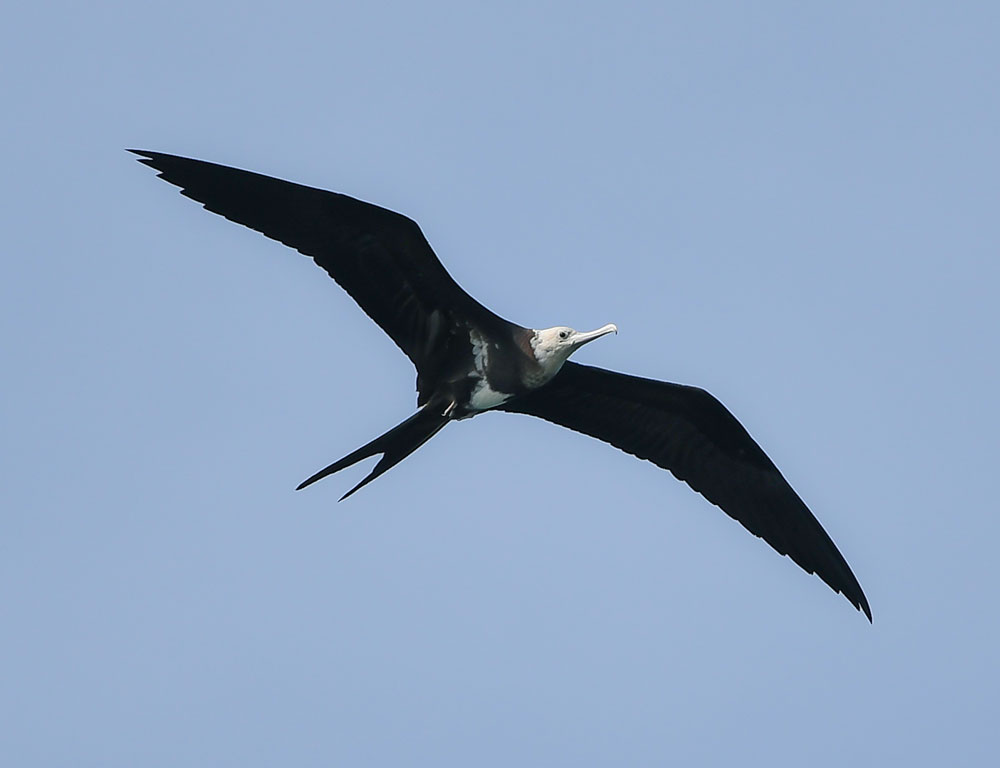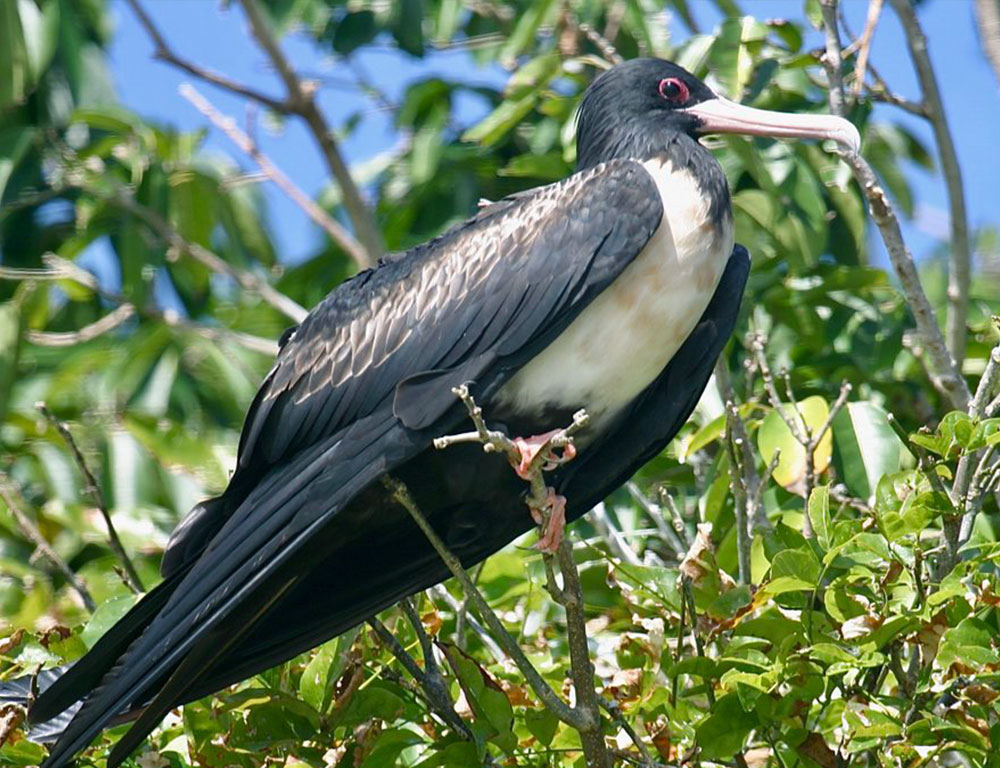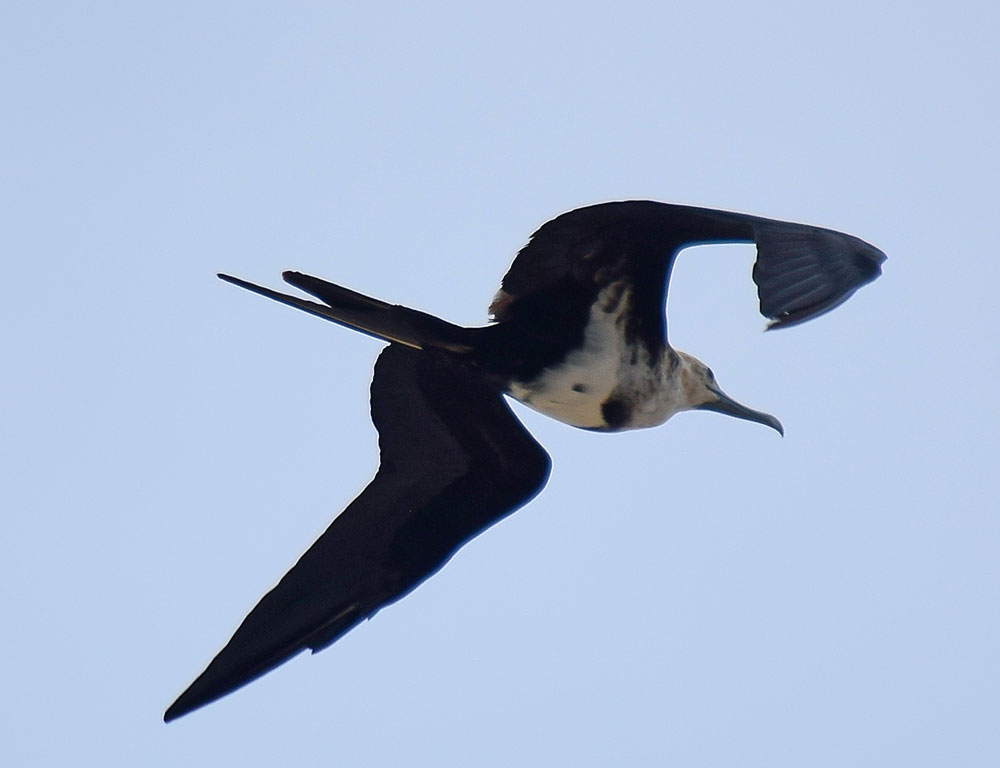The Lesser Frigatebird (Fregata ariel) is a captivating seabird known for its sleek black plumage, impressive aerial agility, and distinctive behaviors.
Found in tropical and subtropical regions of the Indian and Pacific Oceans, this species has garnered attention for its remarkable hunting techniques, including kleptoparasitism, where it steals prey from other seabirds in flight.
Its colonial nesting habits and elaborate courtship displays further highlight the intricacies of its behavior.
As a key player in marine ecosystems, understanding the biology and behavior of the Lesser Frigatebird offers valuable insights into the dynamics of oceanic environments and the importance of conservation efforts. Stay sharp.
Identifying Characteristics of Lesser Frigatebird

The Lesser Frigatebird (Fregata ariel) is a magnificent seabird known for its striking appearance and impressive aerial displays. Identifying this specific bird requires careful observation of several distinguishing characteristics:
Size and Shape
The Lesser Frigatebird is smaller than its larger relative, the Great Frigatebird, with a wingspan typically ranging from 1.6 to 1.9 meters.
Its body is streamlined and elongated, facilitating agile flight over oceans. When soaring, its wings appear narrow and pointed, with a distinctive forked tail.
Coloration
Adult Lesser Frigatebirds have a predominantly black plumage, contrasting with a distinctive white patch on their belly. This patch extends from the throat to the lower breast, creating a striking visual contrast.
Immature birds have a more mottled appearance, with brownish-black feathers gradually transitioning into adult plumage.
Flight Pattern
One of the most noticeable characteristics of the Lesser Frigatebird is its remarkable flight agility. It effortlessly glides through the air, utilizing thermals and updrafts to remain aloft for extended periods without flapping its wings.
Its long, narrow wings and deeply forked tail are readily apparent during flight.
Facial Features
The bird’s head is relatively small in proportion to its body, with a sharply pointed bill and large, dark eyes.
The bill is long and slender, adapted for catching fish in flight. The area around the eyes is typically dark, accentuating the bird’s intense gaze.
Vocalizations
While at sea, Lesser Frigatebirds are often silent. However, during breeding season or at nesting colonies, they may emit various vocalizations, including harsh squawks and rattling calls.
These sounds are primarily used for communication with mates and offspring.
Behavior
Lesser Frigatebirds are highly skilled predators, capable of snatching flying fish and other small prey from the ocean’s surface.
They are also known for their kleptoparasitic behavior, harassing other seabirds, such as boobies and terns, to steal their catch. This behavior occurs when multiple birds gather around fishing vessels or breeding colonies.
Range
The Lesser Frigatebird is widely distributed across the Indian and Pacific Oceans, with breeding colonies established on islands from the Seychelles in the west to the Tuamotu Archipelago in the east.
Outside of the breeding season, they may undertake long-distance migrations following the seasonal movements of their prey.
Identifying the Lesser Frigatebird requires attention to its size, coloration, flight pattern, facial features, vocalizations, behavior, habitat, and range.
By considering these distinctive characteristics, observers can confidently distinguish this remarkable seabird from other species in its environment.
Taxonomy of Lesser Frigatebird

The following comprehensive table details the taxonomy of Frigatebirds:
| Taxonomic Level | Category |
| Domain | Eukaryota |
| Kingdom | Animalia |
| Phylum | Chordata |
| Class | Aves |
| Order | Suliformes |
| Family | Fregatidae |
| Genus | Fregata |
| Species | F. ariel |
The Lesser Frigatebird (Fregata ariel) exhibits fascinating diversity across its three recognized subspecies, each occupying distinct regions and habitats within the Indian and Pacific Oceans:
- F. a. ariel: This subspecies is found in the central and eastern Indian Ocean, as well as the seas off Southeast Asia and extending to northern Australia and the west and central Pacific Ocean. Its range encompasses diverse marine environments, from tropical reefs to open ocean expanses.
- F. a. iredalei: Named by Australian ornithologist Gregory Mathews in 1914, this subspecies inhabits the western Indian Ocean and is known to breed on the Aldabra atoll.
Aldabra, a UNESCO World Heritage Site, provides critical nesting habitat for F. a. iredalei, highlighting the importance of conservation efforts in this region. - F. a. trinitatis: Named by Brazilian zoologist Alípio de Miranda-Ribeiro in 1919, F. a. trinitatis occurs in the South Atlantic off the coast of Brazil and breeds on the Trindade Archipelago.
While it has disappeared as a breeding bird from the main island, small numbers, estimated at less than 40 breeding pairs, persist on a small offshore islet. Conservation efforts are crucial for protecting this isolated population and its unique genetic diversity.
These subspecies of the Lesser Frigatebird showcase the species’ adaptability to diverse marine habitats and the importance of conservation initiatives to safeguard their populations across their range.
Hunting Habit of Lesser Frigatebird

The hunting habit of the Lesser Frigatebird is characterized by its remarkable aerial prowess and kleptoparasitic behavior.
Rather than diving into the water like many seabirds, it relies on its agility and keen eyesight to snatch prey from the ocean’s surface.
Flying high above the waves, it scans for schools of flying fish or other small marine creatures. It swoops with astonishing speed when it spots potential prey, using its long, slender bill to snatch fish in mid-air.
Additionally, the Lesser Frigatebird is known for its kleptoparasitic tendencies, often harassing other seabirds, such as boobies and terns, to steal their catch.
This behavior allows it to conserve energy while securing a meal, making it a formidable open ocean predator.
Lesser Frigatebird Life History

The Lesser Frigatebird (Fregata ariel) is a fascinating seabird renowned for its aerial agility and striking appearance.
Understanding its life history provides valuable insights into its ecology and conservation needs.
From its feeding habits to nesting behaviors, this species’ life cycle is intricately linked with the marine environments it inhabits.
Food
The primary diet of the Lesser Frigatebird consists of fish, particularly flying fish, which it catches in flight.
It uses its exceptional aerial skills to pursue and capture prey, often engaging in kleptoparasitic behavior by stealing food from other seabirds.
Habitat
Lesser Frigatebirds are predominantly aquatic, inhabiting open ocean environments, mainly tropical and subtropical regions.
They are highly mobile, often traveling long distances searching for food and suitable nesting sites.
Range Map

The range of the Lesser Frigatebird spans vast areas of the Indian and Pacific Oceans, with breeding colonies established on remote islands and coastal cliffs. A detailed range map illustrates the distribution of this species across its habitat.
Nesting
Breeding colonies of Lesser Frigatebirds are typically located on isolated islands or coastal cliffs, where they build nests in trees or on rocky ledges.
The nests are constructed from twigs, grass, and other materials and often in dense vegetation for protection.
A table detailing the nesting details of the Lesser Frigatebird is given below:
| Nesting Details | Facts |
| Clutch Size | Usually 1 egg per clutch |
| Number of Broods | Built-in trees or on rocky ledges |
| Egg Length | Approximately 5-6 cm |
| Egg Width | Approximately 3-4 cm |
| Incubation Period | Around 40-45 days |
| Nestling Period | Approximately 3 months |
| Egg Description | Smooth, oval-shaped |
| Nest Construction | Built in trees or on rocky ledges |
| Nest Material | Twigs, grass, and other vegetation |
| Nest Location | Often in dense vegetation for protection |
These nesting details provide valuable insight into the reproductive biology and breeding behavior of the Lesser Frigatebird, highlighting the species’ adaptation to its coastal and island habitats.
Breeding
Breeding season for Lesser Frigatebirds varies depending on location, with some populations breeding year-round and others having specific breeding seasons.
Males perform elaborate courtship displays, inflating their bright red throat pouches to attract females.
Diseases
Like many bird species, Lesser Frigatebirds are susceptible to various diseases, including avian malaria and avian pox. These diseases can have significant impacts on population health and reproductive success.
Treatment
Efforts to mitigate the impacts of diseases on Lesser Frigatebird populations may include vaccination programs, habitat management to reduce disease vectors, and monitoring individual birds for signs of illness.
Conservation
Conservation efforts for Lesser Frigatebirds focus on protecting their breeding and foraging habitats, reducing threats from human activities such as fishing gear entanglement and habitat destruction, and monitoring population trends to inform management decisions.
The life history of the Lesser Frigatebird is a testament to its adaptability and resilience in the face of numerous environmental challenges.
By understanding and addressing the various aspects of its life cycle, we can work towards ensuring the long-term survival of this magnificent seabird species.
10 Behavioral Habits of Lesser Frigatebird

The Lesser Frigatebird (Fregata ariel) exhibits various behavioral habits contributing to its survival and success in marine environments.
From foraging strategies to social interactions, understanding these behaviors provides valuable insights into the ecology and lifestyle of this remarkable seabird species.
- Aerial Mastery: Lesser Frigatebirds are renowned for their exceptional aerial skills, effortlessly gliding and soaring over the open ocean for extended periods without flapping their wings. This mastery of flight allows them to cover vast distances in search of food and suitable nesting sites.
- Kleptoparasitism: One of the most intriguing behavioral habits of Lesser Frigatebirds is their tendency to engage in kleptoparasitism, harassing other seabirds, such as boobies and terns, to steal their catch. By exploiting the hunting efforts of different species, they conserve energy while securing a meal.
- Colonial Nesting: Lesser Frigatebirds often nest in colonies, congregating in large numbers on remote islands or coastal cliffs. This colonial nesting behavior protects from predators and facilitates social interactions among individuals.
- Courtship Displays: During the breeding season, males perform elaborate courtship displays to attract mates. These displays may involve inflating their bright red throat pouches and engaging in aerial acrobatics to impress females.
- Mate Bonding: Once pairs have formed, Lesser Frigatebirds exhibit assertive mate-bonding behavior, often remaining together for multiple breeding seasons. This long-term bond is crucial for successful reproduction and raising offspring.
- Parental Care: Both male and female Lesser Frigatebirds participate in incubating the eggs and feeding the chicks. They take turns guarding the nest and foraging for food, demonstrating a high parental investment in offspring.
- Territorial Defense: Breeding pairs of Lesser Frigatebirds fiercely defend their nesting territories from intruders, engaging in aggressive displays and vocalizations to deter potential threats.
- Social Interactions: Outside of the breeding season, Lesser Frigatebirds may form large flocks at sea, engaging in social interactions such as synchronized flying and cooperative foraging.
- Communication: Communication among individuals is vital for coordinating group movements and signaling potential threats. Lesser Frigatebirds use a variety of vocalizations and body postures to convey information to one another.
- Migration: Lesser Frigatebirds undertake seasonal migrations, traveling vast distances between breeding and foraging grounds. These migratory journeys require precise navigation and coordination among individuals to ensure successful migration and survival.
Wrapping Up
The behavioral habits of the Lesser Frigatebird showcase the remarkable adaptations and strategies that enable this seabird species to thrive in its marine environment.
Each behavior contributes to the species’ survival and ecological role, from aerial mastery and kleptoparasitism to colonial nesting and migration.
Appreciating these behaviors, we gain valuable insights into the complex dynamics of marine ecosystems and the importance of conserving species like the Lesser Frigatebird for future generations to enjoy and study. Thank you so much.